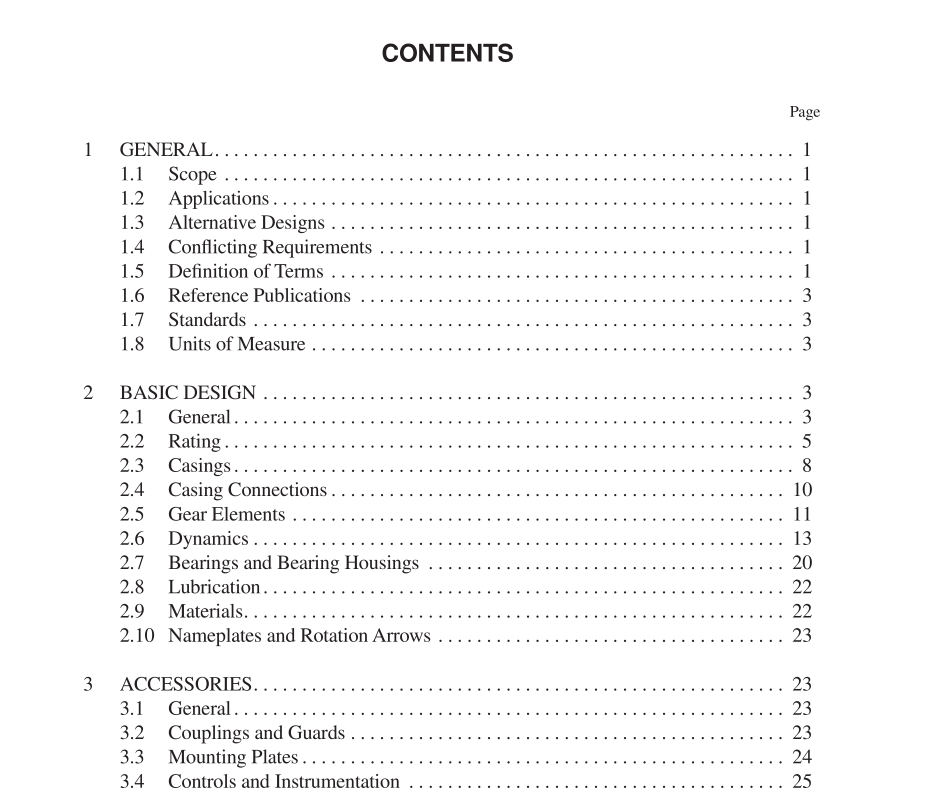API 613 pdf download

API 613 pdf download.Special Purpose Gear Units for Petroleum, Chemical, and Gas Industry Services
1 General
1.1 SCOPE This standard covers the minimum requirements for spe- cial-purpose, enclosed, precision single- and double-helical one- and two-stage speed increasers and reducers of parallel- shaft design for petroleum, chemical and gas industry ser- vices. This standard is primarily intended for gear units that are in continuous service without installed spare equipment. Gear sets furnished to this standard shall be considered matched sets. Note: The purchase of a spare set of gear rotors or a complete gear unit does not mean that the equipment is spared. This standard includes related lubricating systems, con- trols, instrumentation, and other auxiliary equipment. This standard is not intended to apply to gear units in general-pur- pose service, which are covered by API Std 677; to gears inte- gral with other equipment, such as integrally geared compressors covered by Std 617 or Std 672; or to gears other than helical. Note: A bullet at the beginning of a paragraph indicates that either a decision is required or further information is to be provided by the purchaser. This information should be indicated on the data sheets (see Appendix A); otherwise, it should be stated in the quota- tion request or in the order.
1.5 DEFINITION OF TERMS
Terms used in this standard are defined in 1.5.1 through 1.5.38. 1.5.1 axially (horizontally) split refers to casing joints that are parallel to the shaft centerline. 1.5.2 The bending stress number (S) corresponds to the likelihood of fatigue cracking at the tooth root filet. If this stress is excessive, it may lead to failure of the gear teeth. 1.5.3 critical speed is a shaft rotational speed at which the rotor bearing support system is in a state of resonance (see 2.6.1). 1.5.4 The use of the word design in any term (such as design horsepower, design pressure, design temperature, or design speed) should be avoided in the purchaser’s specifica- tions. This terminology should be used only by the equipment designer and the manufacturer. 1.5.5 gauss levels refers to the magnetic field level of a component measured with a “Hall effect” probe, with no interference from adjacent magnetic part or structures. 1.5.6 gear refers to either the pinion or the gear wheel. 1.5.7 The gear service factor (SF) is the factor that is applied to the tooth pitting index and the bending stress number, depending on the characteristics of the driver and the driven equipment, to account for differences in potential overload, shock load, and/or continuous oscillatory torque characteristics. 1.5.8 gear unit is the complete power transmission assembly including the housing, gears, and bearings. 1.5.9 gear unit rated power is the maximum power specified by the purchaser on the data sheet and stamped on the nameplate (see 2.2.1). 1.5.10 gear wheel (bull gear) refers to the lowest speed rotor. 1.5.11 A hunting tooth combination exists for mating gears when a tooth on the pinion does not repeat contact with a tooth on the gear wheel until it has contacted all the other gear wheel teeth. 1.5.12 informative element: Describes part of the stan- dard which is provided for information and to assist in the understanding or use of the standard. 1.5.14 maximum allowable speed (in revolutions per minute) is the highest speed at which the manufacturer’s design will permit continuous operation. 1.5.15 maximum continuous speed (in revolutions per minute) is the speed at least equal to 105% of the rated pinion speed for variable-speed units and is the rated pinion speed for constant-speed units. 1.5.16 mechanical rating is the gear unit rated power (see 1.5.9) multiplied by the specified gear service factor (see 1.5.7). 1.5.17 minimum allowable speed (in revolutions per minute) is the lowest speed at which the manufacturer’s design will permit continuous operation. 1.5.18 normal transmitted power is the power at which usual operation is expected and optimum efficiency is desired. The normal transmitted power may be equal to or less than the gear unit rated power. 1.5.19 normative: A requirement of the standard. 1.5.20 observed: An inspection or test where the pur- chaser is notified of the timing of the inspection or test and the inspection or test is performed as scheduled if the pur- chaser or his representative is not present. 1.5.21 owner: The final recipient of the equipment who may delegate another agent as the purchaser of the equipment. 1.5.22 pinion refers to the highest speed rotor. 1.5.23 profile modification: A calculated machined deviation of the pinion and/or the gear wheel tooth flank from the theoretical tooth form. It is intended to obtain a trapezi- form tooth load transfer distributed evenly along the path of contact in a transverse section when the gears are operating at normal load.









